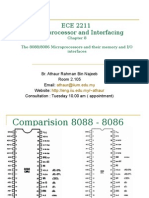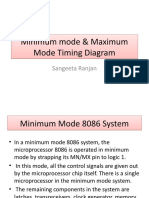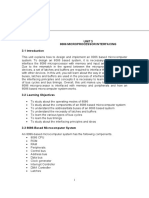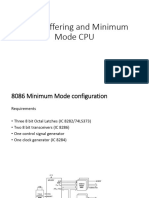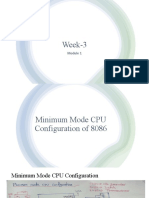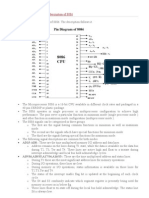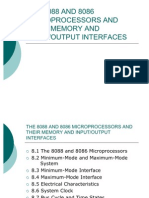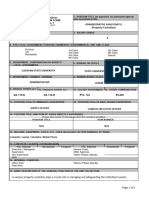6 +8284+Clock+Generator
6 +8284+Clock+Generator
Uploaded by
Jayashreedas1990Copyright:
Available Formats
6 +8284+Clock+Generator
6 +8284+Clock+Generator
Uploaded by
Jayashreedas1990Original Title
Copyright
Available Formats
Share this document
Did you find this document useful?
Is this content inappropriate?
Copyright:
Available Formats
6 +8284+Clock+Generator
6 +8284+Clock+Generator
Uploaded by
Jayashreedas1990Copyright:
Available Formats
8284A Clock Generator: The 8284A is an ancillary component to the 8086/8088 microprocessors.
. Without the clock generator, many additional circuits are required to generate the clock (CLK) in an 8086/8088-based system. The 8284A provides the following basic functions or signals: Clock generation (CLK) RESET synchronization READY synchronization TTL level peripheral clock (PCLK) Pins AEN1 and AEN2
(Address enable)
Function
Used to cause wait states, along with the RDY1 and RDY2 inputs. Wait states are generated by the READY pin of the 8086/8088 microprocessors, which is controlled by these two pins (inputs). Provided in conjunction with AEN1 and AEN2 to cause wait states in an 8086/8088-based system. The ready synchronization selection input selects either one or two stages of synchronization for the RDY1 and RDY2 inputs. READY is an output pin that connects to the 8086/8088 READY input. This signal is synchronized with the RDY1 and RDY2 inputs. An external crystal oscillator is connected to these inputs. =1, an external clock is provided to the EFI input pin. =0, an external crystal oscillator connected to X1 and X2 provides the clock. Supplies the timing whenever the F/C is high. Provides CLK input signal to the 8086/8088 microprocessors and other components in the system. fclk =1/3 (fcrystal/EFI), Duty cycle = 33% which is required by 8086/8088. Provides clock signal to peripheral devices (slower as compare to microprocessor). fPCLK = 1/6 (fcrystal/EFI), Duty cycle = 50%. TTL level signal output. Provides an EFI input to other 8284A clock generators in some multiple processor systems. Active low input. Often connects to an RC network that provides poweron resetting. Connects to the 8086/8088 RESET input pin. Used whenever the EFI input provides synchronization in systems with multiple processors. If the internal crystal oscillator is used, this pin must be grounded. Connects to ground. Connects to +5.0V with a tolerance of +10 percent.
RDY1 and RDY2
(Bus ready)
ASYNC
(Ready synchronization)
READY X1 nad X2
(Crystal inputs)
F/C
(Frequency/Crystal select)
EFI
(External Frequency Input)
CLK
(Clock)
PCLK
(Peripheral clock)
OSC (Oscillator) RES (Reset input) RESET (Reset output) CSYNC
(Clock synchronization)
GND Vcc
Bus Cycle: Bus Cycle defines the basic operation that a microprocessor performs to communicate with external devices. Bus Cycle is the period of time in which 8086/8088 microprocessors uses the memory and I/O. Each Bus Cycle equals four system clocking periods (T states). These four clocking periods are denoted as T1, T2, T3 and T4. During T1: The address of the memory or I/O location is sent out via the address/data bus connections. Control signals ALE, DT/R and IO/M (8088) or M/IO (8086) are generated. The IO/M or M/IO signal indicates whether the address bus contains a memory address or an I/O device (port) number. During T2: The 8086/8088 microprocessor issue the RD or WR signal, DEN and in the case of a write, the data to be written appears on the data bus. These events cause the memory or I/O device to begin to perform a read or write. DEN signal turns on the data bus buffers, if they are present in the system. So, for read operation microprocessor can accept the data read from the memory or I/O and the data are sent out to the memory or I/O through the data bus in write bus cycle. During T3: READY is sampled at the end of T2. If READY is low at this time, T3 becomes a wait state (Tw). This clocking period is provided to allow the memory time to access data. If this bus cycle is happened to be a read bus cycle, the data bus is sampled at the end of T3. During T4: All bus signals are deactivated in preparation for the next bus cycle. This is also the time when the 8086/8088 microprocessors sample the data bus connections for data that are read from memory or I/O. Also the trailing edge of the WR signal transfers data to the memory or I/O, which activates and writes when the WR signal returns to a logic 1 level.
Bus Cycles of 8086/8088: The bus cycles present in 8086/8088 are: Opcode fetch Memory read Memory write I/O read I/O write Interrupt acknowledge
Bus Buffering and Latching: In any microprocessor based system the multiplexed buses must be demultiplexed first. The address/data bus on the 8086/8088 is multiplexed (shared) to reduce the numbers of pins required for the 8086/8088 integrated circuit. Demultiplexing is required because memory and I/O require that the address remains valid and stable throughout a read or write cycle. If the buses are multiplexed, the address changes at the memory and I/O, which causes them to read or write data in the wrong locations. There are three types of buses present in any microprocessor system for interfacing memory and I/O with microprocessor. Address Bus: provides the memory and I/O with the memory address or the I/O port number. Data Bus: transfers data between the microprocessor and the memory or I/O in the system. Control Bus: provides control signals to the memory and I/O. Buffering the system: For very large systems where more than 10 units load is attached to any bus pin, the entire 8086/8088 system must be buffered. Buffering is used to enhance output currents so that more TTL unit loads may be driven. A fully buffered signal introduces a timimg delay to the system. This causes no difficulty unless memory or I/O devices are used, which function at near the maximum speed of the bus. Latching the address bus: For getting the whole 20 bit address available during a bus cycle, we have to use latches with the multiplexed address/data bus. Whenever the address latch enable (ALE) pin becomes a logic 1, a latch pass the inputs to the outputs. After a short time, ALE returns to its logic 0 condition, which causes the latches to remember the inputs at the time of the change to a logic 0.
READY and Wait State: Causes wait states for slower memory and I/O components. A wait state (Tw) is an extra clocking period, inserted b/w T2 and T3, that lengthens the bus cycle. If one wait state is inserted then the memory access time, normally 460nsec with a 5MHz clock, is lengthened by one clocking period (200nsec) to 660nsec. READY is sampled at the end of T2 and again, if applicable in the middle of Tw. If READY is 0, Tw is sampled between T2 and T3. RAEDY is tested for a logic 0 on the 1 to 0 transition of the clock at the end of T2 and for a logic 1 on the 0 to 1 transition of the clock in the middle of Tw.
Minimum Mode Operation: All the control signals for the memory and I/O are generated by the microprocessor, so it costs less.
Maximum Mode Operation: There are not enough pins on the 8086/8088 for bus control during maximum mode because new pins and new features have replaced some of them. Some of the control signals must be externally generated. This requires the addition of an external bus controller- the 8288 bus controller. Maximum mode is used only when the system contains external coprocessors such as the 8087 arithmetic coprocessor.
You might also like
- Test Procedure - BusbarDocument4 pagesTest Procedure - Busbarmayur dhande67% (3)
- Intrebari PM Din CarteDocument21 pagesIntrebari PM Din CarteRadu100% (2)
- Case Study On SDLCDocument9 pagesCase Study On SDLCShubham SharmaNo ratings yet
- Lecture 3Document24 pagesLecture 3MK Milly100% (1)
- Atlantic Computers: A Bundle of Pricing OptionsDocument4 pagesAtlantic Computers: A Bundle of Pricing OptionsFree GuyNo ratings yet
- 8282,8286,8284Document23 pages8282,8286,8284Relan Soniia100% (1)
- Chapter 6-Hardware StructureDocument38 pagesChapter 6-Hardware Structureresourcesb23ecNo ratings yet
- MicroprocessorDocument15 pagesMicroprocessorAhsan FarooqNo ratings yet
- Features and Modes of 8086Document11 pagesFeatures and Modes of 8086ABHishekNo ratings yet
- Unit-2 MMC 8086Document7 pagesUnit-2 MMC 8086yash kumarNo ratings yet
- Pin Config1 SNKDocument6 pagesPin Config1 SNKKirthi RkNo ratings yet
- Memory and Input Output InterfaceDocument16 pagesMemory and Input Output Interfacerobern ndoloNo ratings yet
- Pin Diagram of 8086 MicroprocessorDocument14 pagesPin Diagram of 8086 Microprocessorkranthi6190No ratings yet
- Min Max ModeDocument37 pagesMin Max ModerajNo ratings yet
- 8086 Pin DiagramDocument9 pages8086 Pin Diagram12343567890100% (2)
- Berry B Brey Part IDocument49 pagesBerry B Brey Part Ikalpesh_chandakNo ratings yet
- ECE 2211 Microprocessor and Interfacing: The 8088/8086 Microprocessors and Their Memory and I/O InterfacesDocument37 pagesECE 2211 Microprocessor and Interfacing: The 8088/8086 Microprocessors and Their Memory and I/O InterfacesZahid Ali ArainNo ratings yet
- ECE 2211 Microprocessor and Interfacing: The 8088/8086 Microprocessors and Their Memory and I/O InterfacesDocument37 pagesECE 2211 Microprocessor and Interfacing: The 8088/8086 Microprocessors and Their Memory and I/O InterfacesSrikanth PrasadNo ratings yet
- SummaryDocument3 pagesSummaryHassan Al BaityNo ratings yet
- Address Multiplexing - Hardware Structure of 8086Document57 pagesAddress Multiplexing - Hardware Structure of 8086Mike ThomsonNo ratings yet
- Pin Diagram of 8086Document21 pagesPin Diagram of 8086Radha SudheeraNo ratings yet
- Timimg DiagramDocument27 pagesTimimg DiagramzxcddxzcdzxscNo ratings yet
- 8086 8088 Hardware SpecificationsDocument28 pages8086 8088 Hardware SpecificationsJac ChanchalNo ratings yet
- Unit 3 8086 Microprocessor InterfacingDocument29 pagesUnit 3 8086 Microprocessor InterfacingDere JesusNo ratings yet
- Unit III 8086 Microprocessor InterfacingDocument26 pagesUnit III 8086 Microprocessor InterfacingRammanohar Lokiya100% (1)
- 8284 Clock Generator + Bus Cycles: Presented By: Dr. Syed Aqeel HaiderDocument18 pages8284 Clock Generator + Bus Cycles: Presented By: Dr. Syed Aqeel HaiderHunain RazaNo ratings yet
- Signal Groups of 8086Document18 pagesSignal Groups of 8086Macdonald DanielNo ratings yet
- Unit III MPMC MaterialDocument33 pagesUnit III MPMC Materialsree2728No ratings yet
- Data Buffering and Minimum Mode CPUDocument35 pagesData Buffering and Minimum Mode CPUAman PrasadNo ratings yet
- Pin Diagram of 8086Document21 pagesPin Diagram of 8086adithya123456100% (5)
- 8087 CoprocessorDocument44 pages8087 CoprocessormridulkhandelwalNo ratings yet
- Microprocessor UNIT-6Document15 pagesMicroprocessor UNIT-6pravin2275767No ratings yet
- Minimum and Maximum ModesDocument21 pagesMinimum and Maximum ModesSubash BasnyatNo ratings yet
- 8086/88 Device SpecificationsDocument22 pages8086/88 Device SpecificationsAyush PurohitNo ratings yet
- Overview or Features of 8086Document33 pagesOverview or Features of 8086Supraja SundaresanNo ratings yet
- Minimum and Maximum Mode CPU ConfigurationDocument21 pagesMinimum and Maximum Mode CPU ConfigurationAmitabh DixitNo ratings yet
- 8086 NotesDocument43 pages8086 NotesSuma LathaNo ratings yet
- Chapter 4 PPTDocument24 pagesChapter 4 PPTMengistu BirukeNo ratings yet
- MP04 - 8086 HardwareDocument12 pagesMP04 - 8086 HardwareEhmed BazNo ratings yet
- Pin Diagram of 8086 and Pin Description of 8086Document12 pagesPin Diagram of 8086 and Pin Description of 8086V'nod Rathode BNo ratings yet
- PPT-3 8088 8086 PinDocument53 pagesPPT-3 8088 8086 PinMadhav Singh100% (1)
- MP8085 2Document38 pagesMP8085 2Ravi TejaNo ratings yet
- Coprocessor 1Document50 pagesCoprocessor 1chandanayadav8490No ratings yet
- Coprocessor AlteredDocument42 pagesCoprocessor Alteredchandanayadav8490No ratings yet
- Iii UnitDocument27 pagesIii UnitDilip Kumar AhirwarNo ratings yet
- Operating Modes of 8086 MicroprocessorDocument9 pagesOperating Modes of 8086 MicroprocessorMOHAMMED ASLAM CNo ratings yet
- Advanced 8086 Microprocessor Trainer: Learning MaterialDocument80 pagesAdvanced 8086 Microprocessor Trainer: Learning Materialk.jp914733No ratings yet
- Files 3-Handouts Lecture 15Document7 pagesFiles 3-Handouts Lecture 15work8No ratings yet
- Bus Timing:: ̅̅̅̅̅) To ̅ 0 For The 8088 and / ̅̅̅ 1 For The 8086. If Data Are ReadDocument6 pagesBus Timing:: ̅̅̅̅̅) To ̅ 0 For The 8088 and / ̅̅̅ 1 For The 8086. If Data Are ReadHassan Al BaityNo ratings yet
- Lecture 8Document103 pagesLecture 8Akshaya ZantyeNo ratings yet
- 8086 Min Max Mode Operations ModifiedDocument78 pages8086 Min Max Mode Operations ModifiedRitu RathiNo ratings yet
- Microprocessor (8086) Microcontroller (8051) : Lecture 5 & 6Document30 pagesMicroprocessor (8086) Microcontroller (8051) : Lecture 5 & 6muhammad irfanNo ratings yet
- 8087 DatasheetDocument22 pages8087 DatasheetLuis HerreraNo ratings yet
- 8085 ArchitectureDocument39 pages8085 Architecturemnnit_nitNo ratings yet
- 80C88Document32 pages80C88Alan AlvarezNo ratings yet
- Timing Diagram 8085 FinalDocument29 pagesTiming Diagram 8085 FinalgokulchandruNo ratings yet
- 80186/80188 High-Integration 16-Bit Microprocessors: Figure 1. Block DiagramDocument33 pages80186/80188 High-Integration 16-Bit Microprocessors: Figure 1. Block Diagrammhenley8059No ratings yet
- Zilog Z-80 Product SpecificationsDocument10 pagesZilog Z-80 Product SpecificationsTheAnonymousLugiaNo ratings yet
- Module 2 - Lecture 8Document24 pagesModule 2 - Lecture 8AQeNo ratings yet
- Preliminary Specifications: Programmed Data Processor Model Three (PDP-3) October, 1960From EverandPreliminary Specifications: Programmed Data Processor Model Three (PDP-3) October, 1960No ratings yet
- Practical Reverse Engineering: x86, x64, ARM, Windows Kernel, Reversing Tools, and ObfuscationFrom EverandPractical Reverse Engineering: x86, x64, ARM, Windows Kernel, Reversing Tools, and ObfuscationNo ratings yet
- R20 Mech - IV Year Course StructureDocument40 pagesR20 Mech - IV Year Course StructureN.S Achyuth AnandNo ratings yet
- Picanol Rapier Machine: Bangladesh University of TextilesDocument22 pagesPicanol Rapier Machine: Bangladesh University of TextilesRidwoan RebontoNo ratings yet
- Blue Solar Charge Controller MPPT: AcceptéDocument14 pagesBlue Solar Charge Controller MPPT: AccepténordenNo ratings yet
- Welcome To Globaltouch West Africa LimitedDocument19 pagesWelcome To Globaltouch West Africa LimitedDyaji Charles BalaNo ratings yet
- Calculate and Selection Result AmperaDocument11 pagesCalculate and Selection Result AmperaSaid AnwarNo ratings yet
- BUS1040 Lecture Week 1 SS21Document32 pagesBUS1040 Lecture Week 1 SS21Raquel Stroher ManoNo ratings yet
- Fibo EaDocument4 pagesFibo EaErick SilvaNo ratings yet
- 44-Teks Artikel-83-2-10-20150816Document7 pages44-Teks Artikel-83-2-10-20150816Natalia TambunanNo ratings yet
- Operations Strategy A Value Chain Approach (David Walters (Auth.)Document398 pagesOperations Strategy A Value Chain Approach (David Walters (Auth.)pippoNo ratings yet
- A. Tanenbaum, H. Bos - Systemy OperacyjneDocument1,137 pagesA. Tanenbaum, H. Bos - Systemy Operacyjnecio zieloneNo ratings yet
- Loss On Heating Test888Document3 pagesLoss On Heating Test888alshutuNo ratings yet
- Winsite WIN1dDocument1 pageWinsite WIN1dan0112No ratings yet
- Module 3 Mid Mod Assessment Study GuideDocument1 pageModule 3 Mid Mod Assessment Study Guideapi-293336914No ratings yet
- Comperison Wheel ChairDocument2 pagesComperison Wheel Chairrajeshk.praja1997No ratings yet
- 2014 02 Data Centers - Is Software-Defined Data Center Next Reality - BeatyDocument3 pages2014 02 Data Centers - Is Software-Defined Data Center Next Reality - BeatymeomeportabNo ratings yet
- VB-72 Material Specification SheetDocument1 pageVB-72 Material Specification SheetBerkah PowerindoNo ratings yet
- IOP3705 Unit 5 Chap 7 Collecting and Analysing Diagnostic InformationDocument6 pagesIOP3705 Unit 5 Chap 7 Collecting and Analysing Diagnostic Informationsyeda salmaNo ratings yet
- Ijrcm 4 IJRCM 4 Vol 8 2018 Issue 12 AbstractDocument15 pagesIjrcm 4 IJRCM 4 Vol 8 2018 Issue 12 AbstractHasrat AliNo ratings yet
- Assignment On Aggregate PlanningDocument3 pagesAssignment On Aggregate PlanningYskael LeeNo ratings yet
- Risk Assessment TemplateDocument183 pagesRisk Assessment TemplateAkeem RodriguezNo ratings yet
- ChargePerformanceData OWEN OIL TOOLSDocument8 pagesChargePerformanceData OWEN OIL TOOLSCuenta InformacionNo ratings yet
- Apache NifiDocument9 pagesApache NifimanideepNo ratings yet
- Machine Start-up Checklist - ExtrusionDocument6 pagesMachine Start-up Checklist - ExtrusionSujatha ThomasNo ratings yet
- RS-RA-N01-AL User Manual of Photoelectric Total Solar Radiation TransmitterDocument11 pagesRS-RA-N01-AL User Manual of Photoelectric Total Solar Radiation TransmittermohamadNo ratings yet
- Lennox - KCCDocument46 pagesLennox - KCCtquercy.masterNo ratings yet
- Position Description Form DBM CSC Form No. 1 NewDocument2 pagesPosition Description Form DBM CSC Form No. 1 NewJoe HanNo ratings yet
- Sample Workplace Inspection ChecklistDocument5 pagesSample Workplace Inspection ChecklistDoaa GamalNo ratings yet

















